
* In the 1930s, the Grumman Aircraft Company developed a small twin-engine flying boat, the "Goose", that proved popular in both civil and military roles, with notable service in World War 2. Following up the success of the Goose, Grumman developed the similar but downscaled "Widgeon" flying boat, then the upscaled "Mallard", and finally the further upscaled "Albatross" -- which saw action in both the Korean and Vietnam Wars. This document provides a history and description of the Grumman flying boats.
* The Grumman Aircraft Company was established on Long Island, New York, by Leroy Grumman and a group of other engineers in 1929. They had all worked for the Loening Company, but parted ways when Loening relocated, the split being amicable. Grumman initially established itself with the FF ("Fifi") biplane naval fighter, and the JF ("Duck") biplane floatplane.
In 1936, a group of Long Island millionaires approached the Grumman company to ask for a flying boat aircraft they could use to fly from Long Island to New York City. There were other potential markets, and so Grumman went ahead on the project. The first "G-21" performed its initial flight on 29 May 1937. Trials going well, it was put into production.
The G-21 was of conventional flying boat configuration, with a stepped boat hull, a high wing with fixed floats, and a strut-braced tailplane. It was an amphibian, with a fixed tailwheel, and mainwheels that hand-cranked up into the fuselage. It was mostly made of aircraft aluminum, though the trailing half of the wing and all of the flight control surfaces, except for the flaps, were fabric-covered. Flight control surface arrangement was conventional -- ailerons, one-piece flaps, elevators, rudder, plus trim tabs. The flaps were "split", hinging down from underneath the rear edge of the wing. All control surfaces were manually actuated, except for hydraulically-actuated flaps.
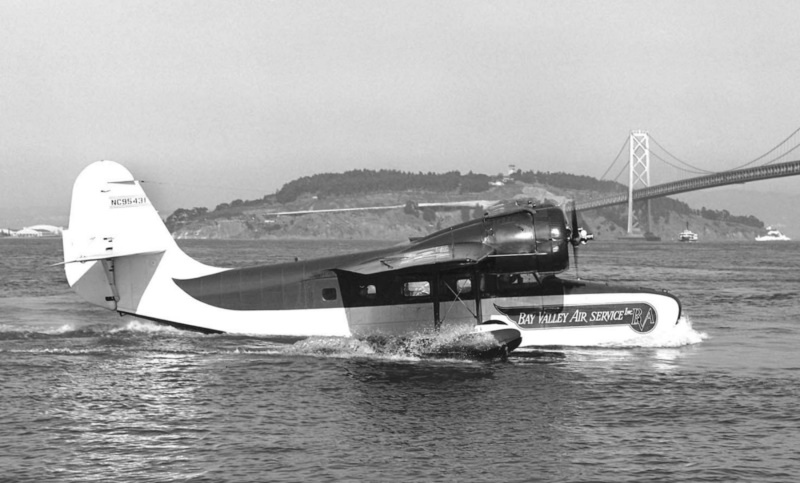
The G-21 was powered by twin nine-cylinder, air-cooled Pratt & Whitney (PW) R-985-SB Wasp Junior radial engines with 335 kW (450 HP) each, driving two-blade constant-speed variable-pitch propellers. Fuel capacity was 834 liters (220 US gallons), using integral tanks in the wings. The G-21 had two aircrew and up to six passenger seats -- though since it was originally built as an executive aircraft, at the outset it typically had two or three seats, along with luxury fittings. It had a split door on the rear left fuselage, the bottom part hinged forward, the top part hinged up. There was a hatch in the nose, primarily to assist docking.
The G-21 had distinctive "tombstone"-shaped windshield panels, giving it something of a cartoonish and surprised appearance. G-21s used for maritime patrol would also usually have a bulged observation window on each side. It was Grumman's first monoplane and first twin-engine aircraft. Its performance, for the time and for what it was, was zippy.
Only 12 G-21s were built. They were followed by 30 "G-21A" machines, which were much the same, but had maximum take-off weight (MTOW) raised from 3,400 to 3,630 kilograms (7,500 to 8,000 pounds). The G-21s were brought up to G-21A spec. One G-21A was sold to the Royal Canadian Air Force (RCAF) in 1938, followed in that year by the sale of 26 to the US Army Air Corps adopted the G-21 as the "OA-9". During the war years, the US Army Air Forces -- which superseded the Air Corps in 1941 -- also impressed seven or eight civilian Geese, giving them the designation, with G-21s retaining the designation of OA-9, and G-21As being designated "OA-13A".
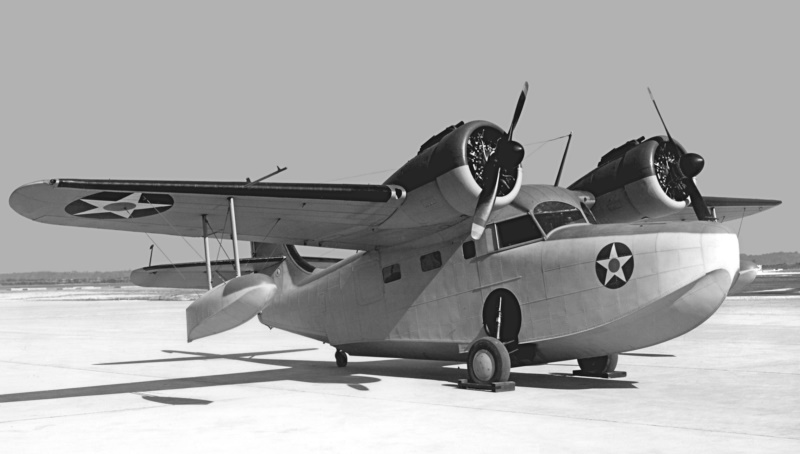
The US Navy obtained a G-21A in 1938 as well, running it through an evaluation as the "XJ3F-1". The evaluation going well, the Navy ordered ten more as the "JRF-1", with one transferred to the US Marines. Subsequent variants included:
A total of 345 Geese was built. Early in the conflict, US Navy and Coast Guard JRFs performed many submarine patrols off the coasts of the USA, but as the German U-boat threat subsided, they reverted primarily to the utility transport and ASR roles. The Navy abandoned the Goose soon after the war, but it lingered in USCG service into the mid-1950s.
___________________________________________________________________
GRUMMAN JRF-5 GOOSE:
___________________________________________________________________
wingspan:
14.94 meters (49 feet)
wing area:
34.9 sq_meters (375 sq_feet)
length:
11.74 meters (38 feet 6 inches)
height:
4.93 meters (16 feet 2 inches)
empty weight:
2,465 kilograms (5,425 pounds)
MTO weight:
3,635 kilograms (8,000 pounds)
max speed:
325 KPH (200 MPH / 175 KT)
cruise speed:
310 KPH (190 MPH / 165 KT)
service ceiling:
6,495 meters (21,300 feet)
range:
1,030 kilometers (640 MI / 555 NMI)
___________________________________________________________________
After the war, the Goose was flown by the military services of Argentina, Australia, Bolivia, Brazil, Cuba, France, Honduras, Japan, Paraguay, Peru, Portugal and Sweden, lingering in service into the 1960s. The McKinnon Company of Sandy, Oregon, sold a series of upgrades of the type:
The Kaman helicopter company converted one JRF-5 into a "tilt-wing" vertical take-off / landing (VTOL) testbed, designated the "K-16B". It had twin General Electric YT58-GE-2A turboprop engines on the tilting wing -- which could tilt to up to 50 degrees from horizontal -- driving oversized three-bladed props. It was run through tests for the US Navy from 1959, but it appears it was unpromising, the program being canceled in 1962 before the machine actually performed a real flight. The K-16B is on display at the New England Air Museum in Windsor Locks, Connecticut.
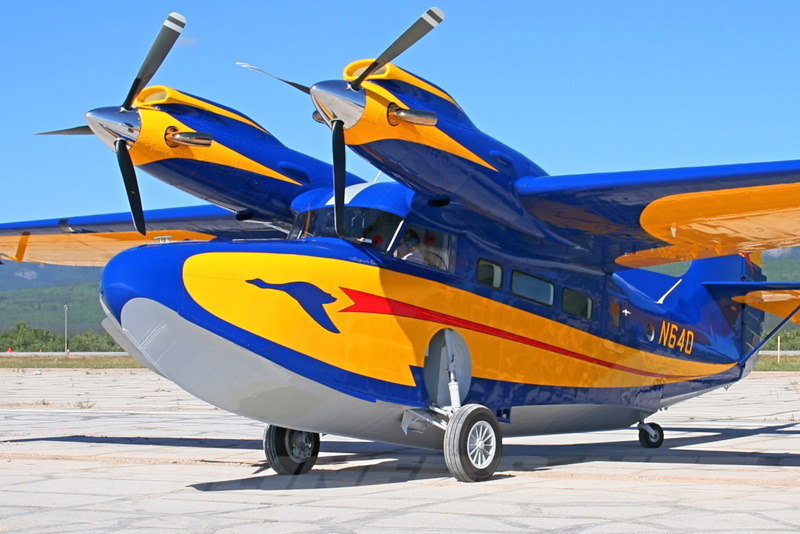
The Goose persists in civil hands, most of them still flying being Turbo-Geese. Antilles Seaplanes of North Carolina even proposed bringing the Goose back into production, using the latest technology, but nothing came of the exercise. However, the Goose is such an excellent aircraft that it may well make a comeback sooner or later.
BACK_TO_TOP* The Goose proving a winner, Grumman then went on to produce a scaled-down derivative, the "G-44", with initial flight in 1940. It went into service with the US Navy in 1941 for anti-submarine patrol. It had almost the same configuration as the Goose, except for being smaller; the most noticeable difference was that it didn't use radial engines, instead being powered by two Ranger L-440-5 air-cooled inverted inline six-cylinder engines with 150 kW (200 HP) each, driving fixed-pitch two-blade wooden propellers.
Otherwise the general arrangement was the same, the Widgeon being a flying boat of all-metal construction -- except for fabric covering of the rear of the wings and the flight control surfaces. There was an integral fuel tank in each wing, total fuel capacity being 409 liters (108 US gallons). Flight control surfaces included, as with the Goose, flaps, ailerons, elevators, and rudder, all manually actuated, except for hydraulically-actuated flaps. The flaps were also single slotted, not split. The landing gear arrangement was the same, except the main gear retracted under hydraulic power. There was a door on the left rear fuselage, in one piece that hinged forward, and a hatch in the nose for docking.
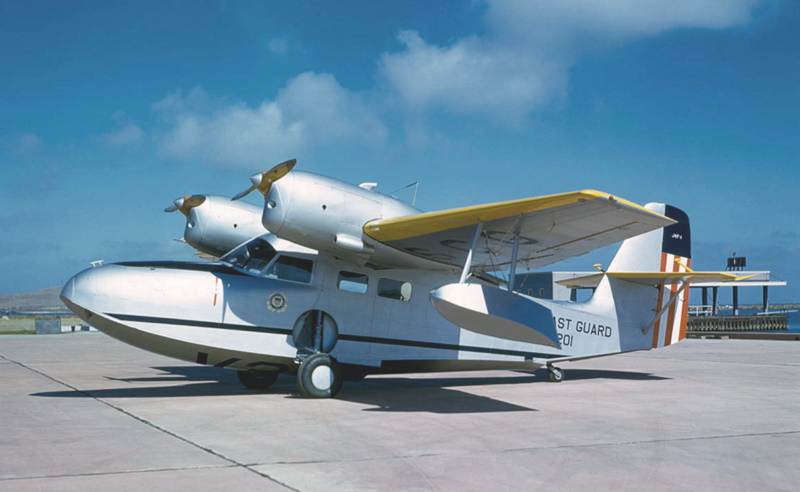
Along with civil G-44s, Grumman built 25 "J4F-1" machines with three seats for the USCG, and 131 "J4F-2" machines with five seats for the US Navy. The USAAF impressed 15 G-44s into service under the designation of "OA-14", and bought one new-build G-44 as an "OA-14A". 15 J4F-2s were passed on to the Royal Navy FAA, being originally and logically designated "Gosling I". However, the British eventually decided to conform to US names to reduce confusion, and so they became "Widgeon I" machines instead. Total production of G-44s of all configurations was 200 aircraft.
___________________________________________________________________
GRUMMAN G-44 WIDGEON:
___________________________________________________________________
wingspan:
12.19 meters (40 feet)
wing area:
22.8 sq_meters (245 sq_feet)
length:
9.47 meters (31 feet 1 inch)
height:
3.48 meters (11 feet 5 inches)
empty weight:
1,470 kilograms (3,240 pounds)
MTO weight:
2,055 kilograms (4,525 pounds)
max speed:
245 KPH (155 MPH / 135 KT)
cruise speed:
220 KPH (140 MPH / 120 KT)
service ceiling:
4,500 meters (14,600 feet)
range:
1,480 kilometers (920 MI / 800 NMI)
___________________________________________________________________
The Widgeon performed sea patrols off the US East Coast early in the war, often by the Civil Air Patrol (CAP) -- an organization of civil aircraft brought into service under military command, often along with their pilots. Wideons were flown, during and after the war, by the military services of Brazil, Cuba, Israel, Portugal, Thailand, and Uruguay.
In 1944, Grumman flew a "G-44A" variant, with a deeper and more hydrodynamically efficient boat hull and six seats. Unlike the Goose, the Widgeon remained in production after the war, being sold to civilian operators. 76 were built by Grumman up to last delivery in 1949. Another 41 were built under license by the Societe de Construction Aero-Navale (SCAN) in La Rochelle, France, these machines being designated "SCAN-30", the last being rolled out in 1954. Most of the SCAN-30s ended up in the American hands. A total of 200 + 76 + 41 == 317 Widgeons was built in all.
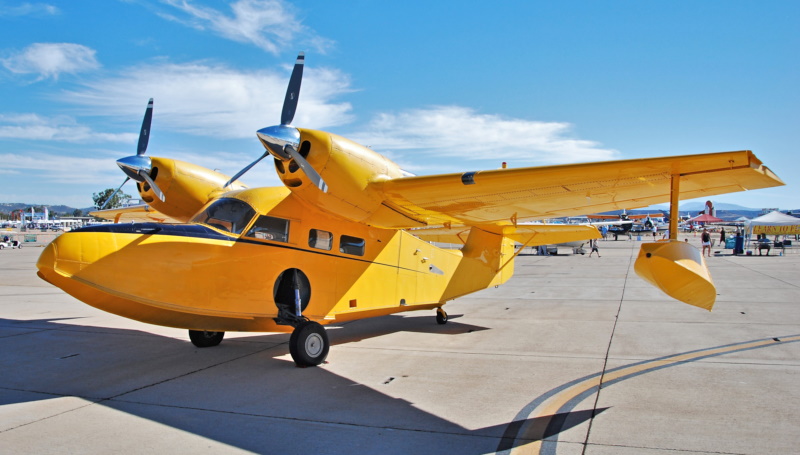
After the war, McKinnon Enterprises rebuilt more than 70 Widgeons to "Super Widgeon" configuration. The primary change was replacement of the Ranger engines with Avco Lycoming GO-480-B1D flat-six air-cooled geared piston engines providing 200 kW (270 HP) each, driving three-bladed variable-pitch props. It also had modernized avionics, bigger windows, improved soundproofing, emergency exits, and increased max operating weight. Retractable wingtip floats were an option.
A number of SCAN 30s were also converted by the Pacific Aerospace Engineering Corporation to "PACE Gannet", later "Gannet Super Widgeon", configuration, featuring Lycoming R-680-13 radial engines with 220 kW (300 HP) each. Many Super Widgeons still fly in civilian hands, with others in static display. One Widgeon survivor at the Pima Air Museum in Tucson, Arizona, named the PETULANT PORPOISE, is unique: it was passed on from the US Navy in 1948 to Edo company, a maker of seaplane floats, to be modified for trials conducted with the US National Advisory Committee for Aeronautics (NACA, the main predecessor organization to the National Aviation & Space Administration, NASA).
It was used for testing flying-boat hull designs, with different hull "slippers" bolted on and then unbolted as necessary. The cockpit floor had to be raised and the flight controls altered to permit fit of the slippers. The PORPOISE was retired in 1954, and later beautifully restored. As it appears on display, it has a hullform emulating that of a Martin P5M Marlin, and features landing gear that pivots back up along the sides,
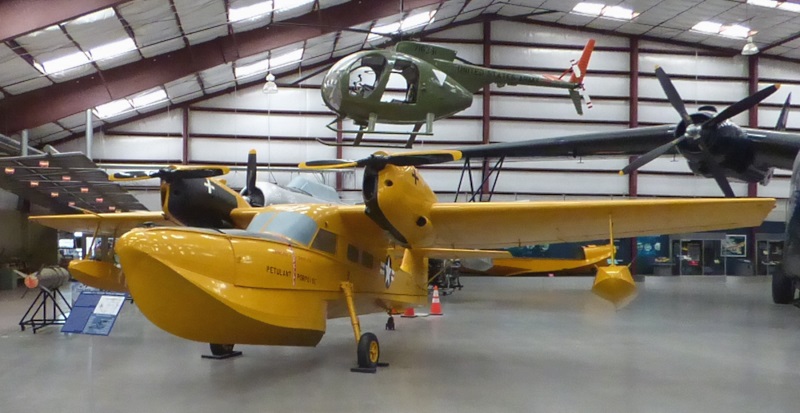
* In 2009 Ellison-Mahon Aircraft, a Seattle-area firm, began tests of their "Gweduck" amphibian flying boat, which looked enough like the Grumman Widgeon to be confused with it on a casual glance. The name was a hybrid of "Widgeon" and "geoduck" -- pronounced "gooey-duck", by the way, and is the name of the burrowing clam well known on the sandy ocean shores in the region. It was designed mostly for the kitbuilder market.
Despite the very similar configuration, the Gweduck was hardly a copy of the Widgeon, in particular being made of composite materials -- mostly vinyl ester resin-impregnated fiberglass and foam cores, often used by boat builders and manufacturers of kitplanes. The Gweduck was also about 15% bigger than the Widgeon.
The Gweduck was powered by twin Lycoming IO-540 flat-six air-cooled piston engines providing 225 kW (300 HP) each, and driving handed three-bladed props. The floats hinged up into the wingtips. Span was 14.63 meters (48 feet) with the floats extended and 15.4 meters (50 feet 6 inches) with them retracted. Wing area was 27.4 square meters (295 square feet), length was 9.91 meters (32 feet 6 inches), and loaded weight was 2,720 kilograms (6,000 pounds). It had six seats, including the cockpit seats. It is unclear if any kits have been sold -- a pity if none, it's a very pretty aircraft.
BACK_TO_TOP* Having downscaled the Goose to the Widgeon, in 1946 Grumman upscaled it to a bigger amphibian flying boat, with the first flight of the "G-73 Mallard" on 30 April 1946, and the type entering service in the fall of 1946. Although clearly a descendant of the Goose, featuring much the same configuration and radial engines, the Mallard was not only larger, but of more modern design -- notably featuring retractable tricycle landing gear.
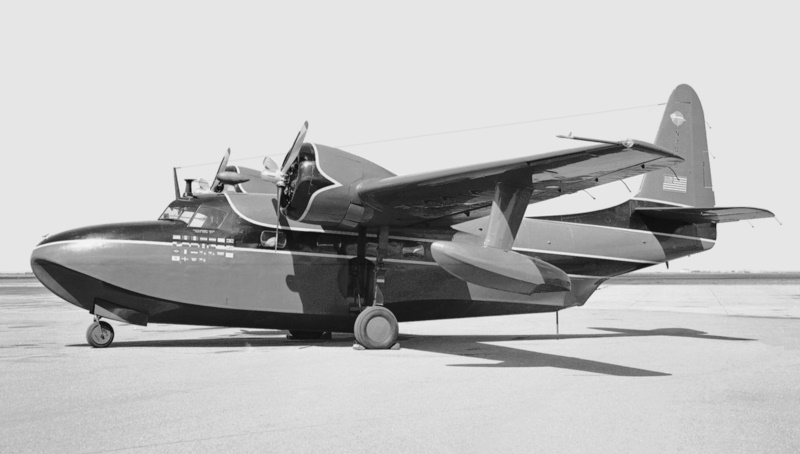
The Mallard was powered by PW R-1340-S3H1 9-cylinder air-cooled radials with 450 kW (600 HP) each, driving three-bladed variable-pitch props. The landing gear was hydraulically retracted, the main gear pulling up into the sides of the fuselage as with the Goose, the nose gear retracting backwards. Flight control surface arrangement was like that of the Goose: ailerons, one-piece slotted flaps, elevators, rudder, and trim tabs. All controls were manually actuated, except for the hydraulically-actuated flaps. A bracing rod could be mounted under the tail to prevent the aircraft from tipping backwards while being loaded. Along with a crew of two, it could carry up to ten passengers. There was a forward-hinged door in the rear, and a hatch for docking in the nose.
___________________________________________________________________
GRUMMAN G-73 MALLARD:
___________________________________________________________________
wingspan:
20.32 meters (66 feet 8 inches)
wing area:
41.3 sq_meters (444 sq_feet)
length:
14.73 meters (48 feet 4 inch)
height (gear down):
5.72 meters (18 feet 9 inches)
empty weight:
4,240 kilograms (9,350 pounds)
MTO weight:
5,785 kilograms (12,750 pounds)
max speed:
345 KPH (215 MPH / 185 KT)
cruise speed:
290 KPH (250 MPH / 155 KT)
service ceiling:
7,010 meters (23,000 feet)
range (max fuel):
2,220 kilometers (1,380 MI / 1,655 NMI)
___________________________________________________________________
The widespread availability of surplus aircraft meant a weak commercial market after the end of the conflict, and only 59 Mallards were built to end of production in 1951. They saw limited commercial service, and also flew as government VIP transports. In the 1970s, at least eight Mallards were refitted by Frakes Aviation with PWC PT6A-27 turboprops, with 505 kw (680 SHP) each, or PT6A-34 turboprops, with 590 kW (750 HP) each, and kitted up to carry 17 passengers -- these aircraft of course becoming "G-73T Turbo Mallards."
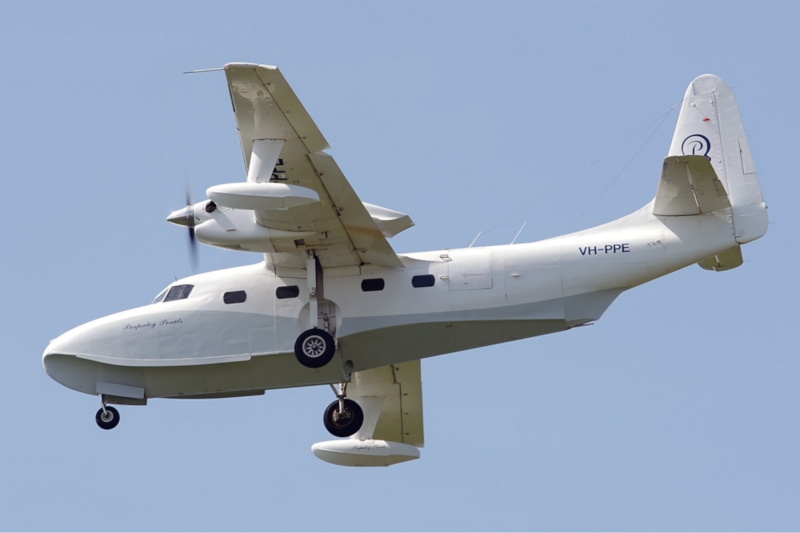
A comparable PT6A upgrade was performed by Paspaley Pearling of Australia -- which, as the name says, is a pearl farming operation -- working with Aeronautical Engineers Australia. There was work towards putting the Mallard back into production in the 1990s, but that effort fell through. There was further talk from 2014 of putting an updated Turbo Mallard into production, but so far nothing has happened.
BACK_TO_TOP* The Mallard design was refined into a larger military aircraft, the Grumman "G-64", which was intended for utility transport, training, plus search and rescue (SAR, the modern term for ASR) roles. Initial flight of the first of two "XJR2F-1 Pelican" prototypes, as it was originally referred to, was on 24 October 1947. It was very similar in appearance to the Mallard, though with an empty weight over twice as great. The first production "Albatross", as it had been renamed, was delivered in to the US Navy in 1949.
The Albatross was clearly a design descendant of the Goose, with the same general configuration, but aerodynamically cleaner, and much bigger. It was of all-metal construction, except for fabric-covered elevators and rudder. It was powered by twin Wright R-1820-76 Cyclone 9 nine-cylinder single-row air-cooled radial engines with 1,065 kW (1,425 HP) each; they drove three-bladed Hamilton Standard variable-pitch, reversible, constant-speed propellers.
Internal fuel supply was 2,555 liters (675 US gallons), plus 1,514 liters (400 US gallons) in the floats; the first six production machines couldn't carry fuel in the floats. The Albatross could also be fitted with two drop tanks as well, with capacities of up to 1,136 liters (300 US gallons).
The wing featured fixed leading-edge slots. Flight control surface arrangement was conventional, with large one-piece flaps, ailerons, elevators, rudder, and trim tabs. The control surfaces were manually actuated, except for hydraulically-actuated flaps and hydraulically-boosted rudder.
The Albatross had a "deep-vee" hull design that allowed to land in rough seas -- though it needed rocket-assisted take-off (JATO) boosters to take off again if the seas were very rough. JATO boosters could be stored in the crew cabin and fitted up from the windows, with two JATO boosters per side. Early production could be fitted with an AN/APS-31 radar pod under a wing; later production moved the radar to the nose, in a distinctive "thimble" antenna fairing.
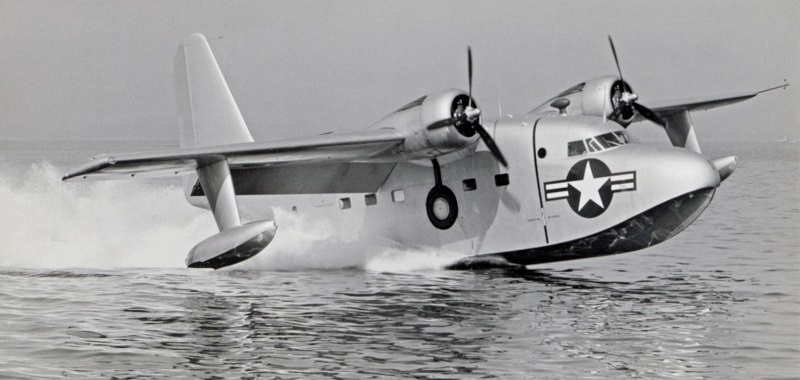
The hydraulically-actuated tricycle landing gear was of the same general configuration as that of the Mallard: main gear tucking up into the sides of the fuselage, nose gear retracting backwards. The only noticeable difference was that the Albatross nose gear had two wheels and not one. Like the Mallard, a removeable tail stand could be fitted under the rear fuselage. From 1953, Grumman produced a quantity of kits that provided a skid under the hull and skis hanging from the nose of the floats, with such a "triphibian" able to operate off land, sea, or snow.
For SAR operations, there were typically six crew: pilot, copilot, navigator, radar operator, flight mechanic, and paramedic -- along with four litters. It could be easily reconfigured to other arrangements:
In the SAR role, sometimes two litters were fitted as crew rest bunks for long patrols. SAR machines, it appears, typically had a bulged window fitted on each side of the fuselage to give observers a good view.
There was a split door on the left rear fuselage, opening top and bottom; a sea rescue platform could be attached at the bottom. There was a hatch in the nose from which a crew member could use a boathook to catch rafts, or help with docking. There was a hatch above each side of the cockpit, and a large hatch on top of the fuselage between the rear of the wings. The big hatch was only used for servicing and for loading bulky items that couldn't fit through the side door.
___________________________________________________________________
GRUMMAN ALBATROSS:
___________________________________________________________________
wingspan:
29.46 meters (96 feet 8 inches)
wing area:
96.2 sq_meters (1,035 sq_feet)
length:
19.15 meters (62 feet 10 inches)
height:
7.87 meters (25 feet 10 inches)
empty weight:
10,380 kilograms (22,885 pounds)
operating weight:
13,770 kilograms (30,355 pounds)
max speed:
380 KPH (235 MPH / 205 KT)
service ceiling:
6,600 meters (21,500 feet)
range:
4,590 kilometers (2,850 / 2,480 NMI)
___________________________________________________________________
The Albatross was originally produced in three similar variants:
A number of Navy UF-1s were winterized for Antarctic use, to be designated "UF-1L"; five UF-1s had dual controls for training, to be designated "UF-1T". In 1962, when the Pentagon adopted a common designation scheme, the designations were updated as follows:
There's a trick with the reassignment of the USCG UF-1Gs to the "HU-16E" designation -- see below. The number of different designations for the first-series Albatross is very confusing; for convenience, it can informally be called the "Albatross 1" -- aping British usage, though Britain never flew it operationally. The Antarctic and trainer subvariants can be similarly labeled "Albatross 1/L" and "Albatross 1/T".
In service, the Albatross sported a range of paint schemes. Aircraft in combat zones tended to be painted in dark gray on top, light gray on bottom, to reduce visibility. USAF Albatrosses otherwise were typically painted in overall aluminum, with red or orange tails, red or yellow wingtips, and other markers of high-visibility colors. US Navy machines tended to have more imaginative coloration -- white upper, black lower, with high-visibility color markers -- while USCG machines were generally painted in stereotypical Coast Guard "creamsicle" colors of white and orange.
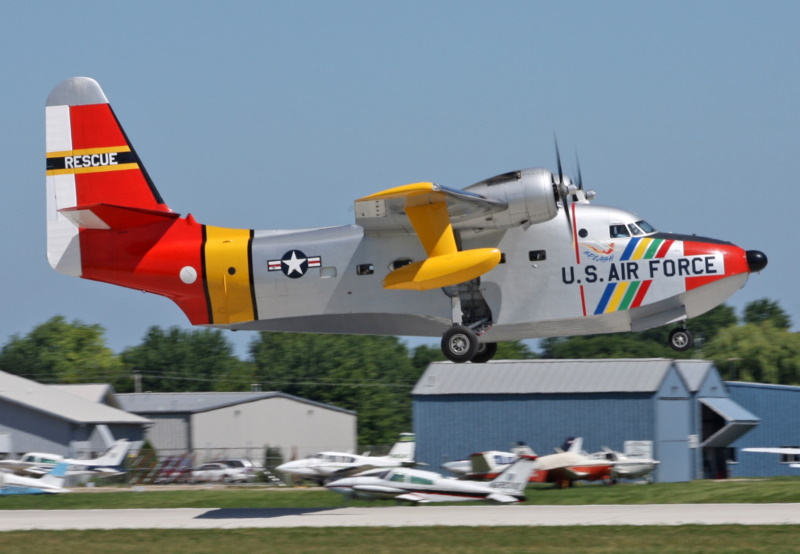
* The Albatross 1 having proven successful, in 1955 Grumman proposed an update to the design, what might be labeled the "Albatross 2". The result, the "Model 111" AKA "SA-16B" performed its initial flight on 15 January 1956. The update included:
Range, payload, and ceiling were increased, at some small penalty in top speed. There were 241 upgrades, with USN machines redesignated "Model 211" AKA "UF-2" and USCG machines redesignated "Model 234" AKA "UF-2G". 21 were also built new, it seems five being attrition replacements for the US military and 16 for export, see below. The 16 export machines featured more powerful R-1820-82 radials with 1,135 kW (1,525 HP) each; this batch of machines could be easily recognized by an airscoop on top of each engine nacelle. They were the final new-build machines, the last being delivered in 1961.
In 1962, the designations were updated as follows:
The reason that both Coast Guard UF-1Gs and UF-2Gs became "HU-16Es" was apparently because all the UF-1Gs were updated to UF-2Gs before the designation change. There is no mention of updated Albatross 1/L winterized machines or Albatross 1/T trainers.
USAF HU-16Bs were used extensively in Vietnam, not merely for SAR, but also for insertion and retrieval of covert action teams. Four were lost in action, the type being retired in 1967 in favor of the Lockheed HC-130 Hercules and the Sikorsky HH-3 Jolly Green Giant helicopter. It seems the Albatross was retired from USAF service not long after that.
___________________________________________________________________
GRUMMAN HU-16B ALBATROSS:
___________________________________________________________________
wingspan:
29.47 meters (98 feet 8 inches)
wing area:
96.2 sq_meters (1,035 sq_feet)
length:
19.16 meters (62 feet 10 inches)
height:
7.87 meters (25 feet 10 inches)
empty weight:
10,400 kilograms (22,885 pounds)
max operating weight:
17,045 kilograms (37,500 pounds)
max speed:
380 KPH (235 MPH / 205 KT)
cruise speed:
200 KPH (125 MPH / 110 KT)
service ceiling:
6,550 meters (21,500 feet)
range:
4,590 kilometers (2,850 MI / 2,480 NMI)
___________________________________________________________________
* Foreign users of new-build Albatrosses included:
That gave a total of 29 new-build Albatrosses for the export market, including 8 Albatross 1s and 21 Albatross 2s. Each batch of machines for export users, incidentally, typically had its own Grumman model code.
The Japanese also obtained a hand-me-down UF-1 from the USA, with the Shin Meiwa Company extensively modifying it into a demonstrator / prototype for their big four-turboprop PS-1 flying boat. The changes to the "UF-XS", as it was designated, included:
It is still on display in a museum in Japan. It was definitely an impressive contraption; it looks like something out of an anime video.
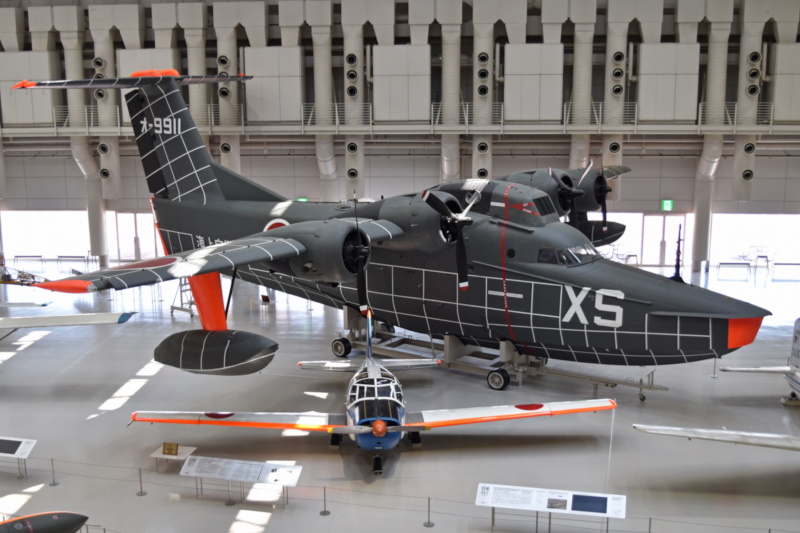
* There was a third distinctive variant of the Albatross, intended as a low-cost anti-submarine warfare (ASW) platform for export use, and designated "SA-16B/ASW", or informally "Albatross 2/ASW". It had a bulbous nose radome for AN/APS-88 search radar; an extensible magnetic anomaly detector (MAD) boom in the tail; and four underwing hardpoints for homing torpedoes, depth charges, or unguided rocket pods.
A searchlight could be mounted under the right wing on one of the hardpoints; it appears it was self-powered, using a spinner. The SA-16B/ASW was also fitted with a signals intelligence receiver to pick up and locate transmissions from submarines. Crew could drop sonobuoys, markers, and "bang" charges – officially called "Signal Underwater Sound (SUS)" charges, incidentally -- through a dispenser mounted in a cabin window.
There was a total of 37 conversions of Albatross 2s to Albatross 2/ASW standard, these machines being provided to six foreign customers initially: Chile, Greece, Norway, Peru, Spain, and Thailand. Norway was the biggest user, obtaining 20. Two of the conversions were evaluated by the US Navy to validate the system before its export, with these two then delivered to foreign users. The variant was redesignated "SHU-16B" in 1962.
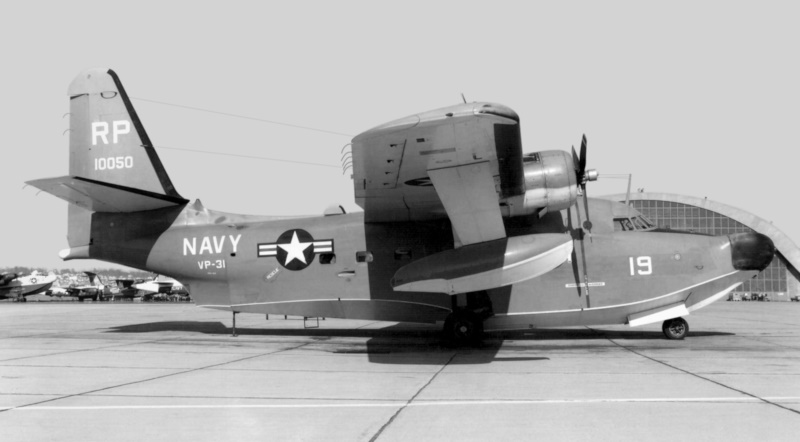
Total production of the Albatross is given as 466 aircraft, including the two prototypes. 443 Albatross 1s were built, along with 21 new-build Albatross 2s, plus 241 conversions to Albatross 2 standard and 37 to Albatross 2/ASW standard. Sources tend to be confusing about Albatross production, with some of the figures here being educated guesswork. There was a lot of trading back and forth of the Albatross over its service history, with Brazil, Italy, Malaysia, Mexico, Pakistan, Philippines, and Taiwan obtaining it second-hand.
The Albatross was phased out of US Navy service in the mid-1970s, and Coast Guard service in the early 1980s; it may have lingered in foreign service longer. The Albatross saw a degree of civil service in the Pacific and Caribbean after its retirement from the military. In the 1970s, Grumman decided to convert retired Albatrosses to a 28-seat airliner configuration, designated the "Model 111" -- recycling the old Grumman Model 111 number for the HU-16B. However, the concept didn't sell, with only 13 conversions made, and those seeing little use.
The problem with the Albatross was that it was too fuel-hungry to be cost-effective as a small airliner. One of the Model 111s was flown by the Smithsonian Institution, in support of international exploration expeditions; another one was converted to an "air tanker" configuration to fight forest fires, but it appears it saw little or no service in that role.
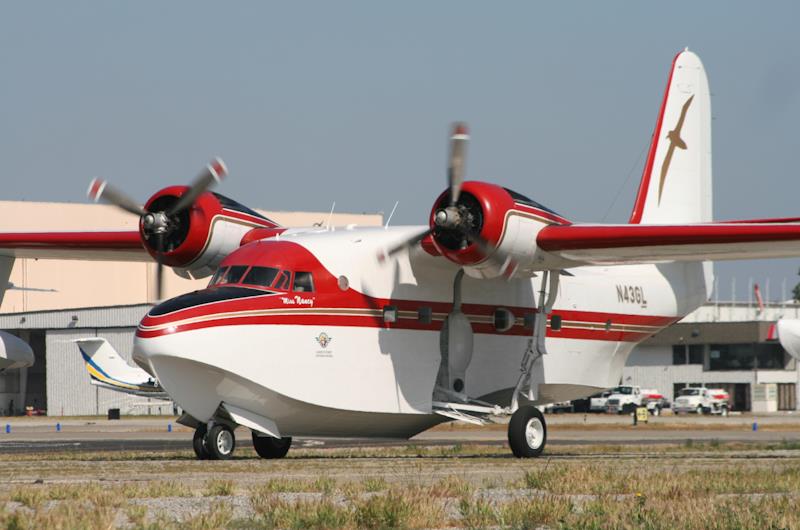
In 1970, Conroy Aircraft re-engined an HU-16A Albatross with Rolls-Royce Dart turboprops, but nobody bought on the concept, and that machine was a one-off. A few machines still linger in civilian hands; satellite technology company Row 44 obtained an HU-16B Albatross to evaluate its in-flight satellite broadband internet service. In 2016, a US-based company named Amphibian Aerospace Industries promised to bring a turboprop-powered Albatross back into production in Australia -- but as with other attempts to build Grumman flying boats again, nothing came of the matter. One hopes it will happen, one of these days.
BACK_TO_TOP* Sources include:
This document was mostly a scavenger hunt from online sources. These aircraft are not well documented.
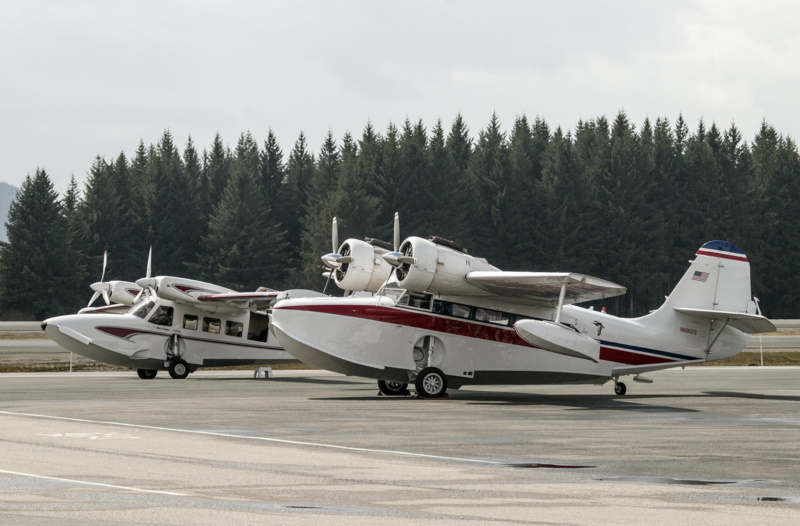
* Illustrations details:
* Revision history:
v1.0.0 / 01 nov 21 v1.0.1 / 01 dec 23 / Review & polish. v1.0.2 / 01 apr 24 / Review & polish. (+)BACK_TO_TOP
